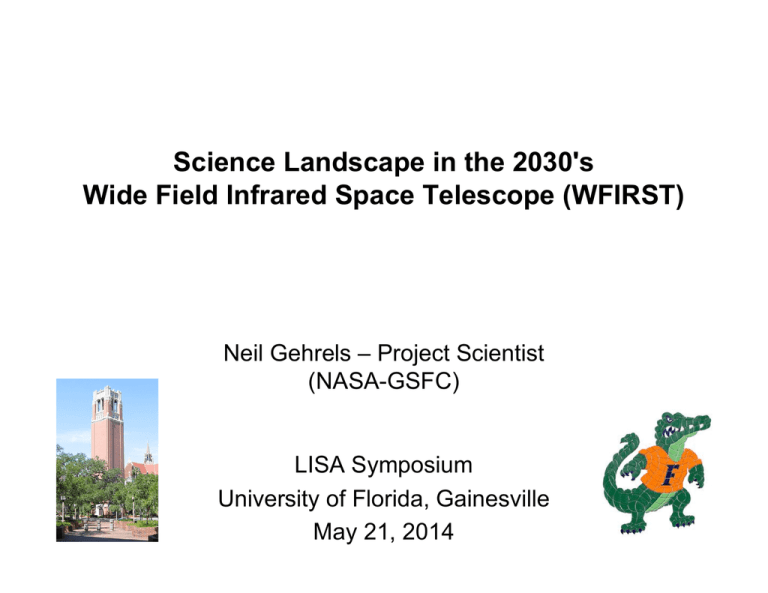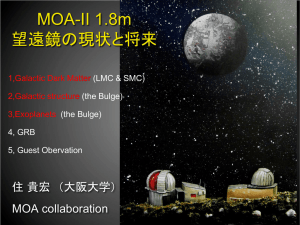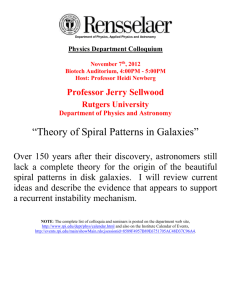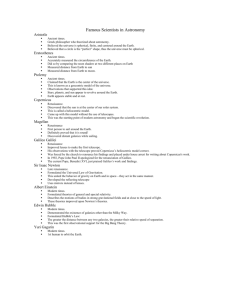Science Landscape in the 2030's Wide Field Infrared Space Telescope (WFIRST)
advertisement

Science Landscape in the 2030's Wide Field Infrared Space Telescope (WFIRST) Neil Gehrels – Project Scientist (NASA-GSFC) LISA Symposium University of Florida, Gainesville May 21, 2014 WFIRST-AFTA SDT Co-Chairs • David Spergel, Princeton University • Neil Gehrels, NASA GSFC Members • Charles Baltay, Yale University • Dave Bennett, University of Notre Dame • James Breckinridge, California Institute of Technology • Megan Donahue, Michigan State University • Alan Dressler, Carnegie Institution for Science • Scott Gaudi, Ohio State University • Tom Greene, NASA ARC • Olivier Guyon, Steward Observatory • Chris Hirata, Ohio State University • Jason Kalirai, Space Telescope Science Institute • Jeremy Kasdin, Princeton University • Bruce MacIntosh, Stanford University • Warren Moos, Johns Hopkins University • • • • • • Saul Perlmutter, University of California Berkeley Marc Postman, Space Telescope Science Institute Bernie Rauscher, NASA GSFC Jason Rhodes, NASA JPL David Weinberg, Ohio State University Yun Wang, University of Oklahoma Ex Officio • Dominic Benford, NASA HQ • Mike Hudson, Canadian Space Agency • Yannick Mellier, European Space Agency • Wes Traub, NASA JPL • Toru Yamada, Japanese Aerospace Exploration Agency Consultants • Matthew Penny, Ohio State University • Dmitry Savransky, Cornell University • Daniel Stern, NASA JPL WFIRST Summary • WFIRST is the highest ranked large space mission in 2010 US Decadal Survey - dark energy - exoplanet census and imaging - NIR sky for the community (GO program) • WFIRST-AFTA uses 2.4m telescope from NRO • Exoplanet coronagraph part of baseline • WFIRST-AFTA will perform Hubble quality and depth imaging over 1000's sq deg • WFIRST-AFTA enabled by large format HgCdTe detectors WFIRST-AFTA Instruments Wide-Field Instrument • Imaging & spectroscopy over 1000s of sq. deg. • Monitoring of SN and microlensing fields • 0.7 – 2.0 micron bandpass • 0.28 deg2 FoV (100x JWST FoV) • 18 H4RG detectors (288 Mpixels) • 6 filter imaging, grism + IFU spectroscopy Coronagraph • Imaging of ice & gas giant exoplanets • Imaging of debris disks • 400 – 1000 nm bandpass • ≤10-9 contrast (after post-processing) • 100 milliarcsec inner working angle at 400 nm Capabilities & Status • Same size and quality telescope as HST • 2.5x deeper and 1.6x better resolution than NWNH WFIRST. Highly complementary to LSST, Euclid and JWST. • Enables coronagraphy of giant planets and debris disks • Use of donated telescope and addition of coronagraph have increased the interest in WFIRST in government, scientific community and public. – $66M add by Congress. Used for pre-Phase A risk reduction & schedule advancement – Funding ramps up in FY18, capturing the JWST funding "wedge" for astrophysics • Cost with coronagraph is $2.1B to $2.4B depending on launcher • Launch date is 2023 to 2024 IR Surveys 6 10 B WFIRST/AFTA HLS 5 Survey Grasp (degrees/arcseconds)2 10 B 2MASS K 4 10 103 Euclid Wide J B B LSST Y POSS-II IR UKIDSS Y B B B B B SDSS-III z 2MASS J UKIDSS K WISE 3µm B CFHTLS Wide z B CFHTLS Deep z 1 10 -1 10 10-2 10 WFIRST/AFTA B SN, Deep B Euclid Deep J 102 1 WFIRST/AFTA B SN, Wide B B CANDELS Wide J B CANDELS Deep J ing s a re n Inc atio m or Inf tent n Co 1 B HUDF/IR -1 10 -2 10 -3 10 -4 10 Flux Sensitivity (mJy) -5 10 -6 10 -7 10 WFIRST-AFTA vs Hubble Hubble Ultra Deep Field - IR ~5,000 galaxies in one image (60 orbits, 4 days) PI: Illingworth 70,000 galaxies in each field of AFTA survey WFIRST-AFTA Deep Field >1,000,000 galaxies in each image WFIRST-AFTA Dark Energy Weak Lensing (2400 deg2) • High angular resolution • Galaxy shapes in IR • 400 million galaxies • Photo-z redshifts • 3 imaging filters Supernovae • High quality IFU spectra • 5 day sampling of light curves • 2500 SNe Redshift survey (2400 deg2) • BAO & Redshift Space Distortions • High number density of galaxies • 20 million galaxies Improvement over SDSS LSST AB mag 28 AFTA 27 26 25 Euclid 24 23 High Latitude Survey is 2.5x fainter and 1.6x sharper thanWFIRST IDRM Hα OIII Euclid Exoplanet Microlensing Monitor 3 sq deg in galactic bulge Exoplanet Surveys Kepler & WFIRST M. Penny (OSU) Exoplanet Surveys Kepler & WFIRST • ~3000 planet detections. • 300 with Earth mass and below. • Hundreds of free-floating planets. WFIRST-AFTA complements Kepler, TESS, and PLATO. M. Penny (OSU) AFTA Coronagraph Capability Shaped Pupil Mask Image with Dark Hole Bandpass 400 – 1000 nm Inner working angle 100 – 250 mas Outer working angle 0.75 – 1.8 arcsec Detection Limit Contrast ≤ 10-9 (after processing) Spectral Res. ~70 Coronagraph Sensitivity -3 10 -10 -5 10 -12 HST Planet/Star Contrast GPI -14 -6 10 JWST -16 -7 10 -18 10-8 -20 -9 10 -10 10 10-11 -22 Jupiter Venus Earth WFIRST-AFTA -24 Saturn Uranus Mars 0.1 1 Angular Separation (arcsec) -26 delta magnitude (mag) -4 10 -8 Self-luminous planets Known RV planets Solar System planets Cosmic Structure Formation History Using Observations from the High Latitude Survey and GO Programs Detection of Large Sample of z > 7 Galaxies Large-scale Distribution of Lyman-break Galaxies Survey of Emission-line Galaxies Large-scale Distribution of Galaxy Clusters Lensing Mass Function of Clusters Dark Matter Halos of Galaxies Present 1 4 6 billion years 1.5 billion years Redshift 5 6 7 750 million years 8 >10 <500 million years Observatory Concept • Telescope – 2.4m aperture primary • Dry Mass –3900 kg • Primary Structure – Graphite Epoxy • Downlink Rate – Continuous 150 Mbps Ka-band to Ground Station • Thermal – passive radiator • Power – 2100 W • GN&C – reaction wheels & thruster unloading • Propulsion – bipropellant • GEO orbit • Launcher – Atlas V 551 or Falcon 9 heavy 15 Wide Field Instrument Layout WF Outer Enclosure Outer enclosure (OE) and optical bench (OB) top panels removed Wide field mirrors; Focal plane assembly (FPA); Integral field unit (IFU) Latches WF Radiator Assembly OB Radiator (Blue) Cryocooler/Electronics Radiator (Red) 16 Coronagraph Instrument Shaped-pupil mask Deformable mirrors (2X) LOWFS camera Fast steering mirror Hybrid Lyot mask imaging camera IFS camera side view end view (from inside) 17 EM Counterparts to GW Sources "Ground-based detectors such as LIGO will detect high-frequency (HF) gravitational waves ( 10 − 1000Hz). They can detect the merging of binary black holes, and the tidal disruption and merger of neutron stars in black hole and neutron star binaries at 400Mpc and 200Mpc respectively.... The space-based mission LISA will detect low-frequency (LF) gravitational waves (0.1-10mHz). It can detect merging binary supermassive black holes (to z 30), their captures of intermediate mass black holes (to z 3), and their captures of the compact objects (stellar mass black holes to z 1, neutron stars and white dwarfs to z 0.1 ) in galactic nuclei." Phinney Astro2010 WP Notes on EM Counterparts LIGO-Virgo: • Most likely early detections will be NS-NS or NS-BH mergers • Range is 50 – 200 Mpc • Accompanied by bright GRB and afterglow if on jet axis (1%) • Accompanied by faint afterglow, possibly from kilonova nucleosynthetic radionuclides, if off-axis LISA: • Most likely detections will be binary SMBH mergers • Range is Gpc's • Bare BH mergers have no EM radiation. However: - Gas around BHs will be stirred up and accrete forming quasar on years to decades time scales - Stars around BHs will be stirred up and create TDE events on years to decades time scales Swift Finding: NS-NS Mergers Produce Short GRBs Credit: Daniel Price and Stephan Rosswog Swift Finding: Tidal Disruption Event Produces EM Transient Source Localization Errors LIGO-Virgo LISA 3 deg Lang, Hughes, Cornish '12 Mock Data Challenge Group 1 2 3 Aasi+ '13 Error (deg) 11.6 2.0 171.0 Babak+ '10 LIGO-Virgo Error Boxes – Galaxy Strategy 1000 deg2 2015 tiling - WFIRST •• • 100 deg2 2017 10 deg2 2020 galaxies # galaxies to cover 50% of light WFIRST FoV = 0.28 deg2 Kanner, Gehrels+ '12 GRB and GW Afterglows GRB Optical/NIR Afterglow NS-NS mergers produce GWs & GRBs long GRBs short GRBs WFIRST-AFTA Kann+ '08 • • • WFIRST NWNH JWST EM afterglows are bright, but short-lived Summary • WFIRST-AFTA is a (now more) powerful mission for NIR surveys and exoplanets - HST imaging & spectroscopy with 100x field of view - First high-contrast coronagraph for imaging exoplanet Jupiters and debris disks - First space microlensing census of exoplanets • Coronagraph is descopable, but important scientifically and politically • If WFIRST can launch in 2024, substantial funds for new future missions or involvement in missions will become available in ~2023. • WFIRST-AFTA will be a useful tool for follow-up of LIGO-Virgo and LISA GW events







